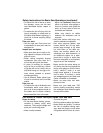
35
Safety Instructions for Basic Saw Operations
Before Each Use
Inspect your saw.
• To reduce the risk of injury from
accidental starting, turn the switch
off, unplug the saw, and remove
the switch key before raising or
removing the guard, changing the
cutting tool, changing the setup, or
adjusting anything.
• Check for alignment of moving
parts, binding of moving parts,
breakage of parts, saw stability,
and any other conditions that may
affect the way the saw works.
• If any part is missing, bent or bro-
ken in any way, or any electrical
part does not work properly, turn
the saw off and unplug the saw.
• Replace damaged or missing parts
before using the saw again.
• Use the sawblade guard, spreader
and anti-kickback pawls for any
thru-sawing (whenever the blade
comes through the top of the work-
piece). Make sure the anti-kickback
pawls work properly. Make sure the
spreader is in line with sawblade.
• Remove adjusting keys and
wrenches. Form a habit of check-
ing for and removing keys and
wrenches from table top before
turning saw on.
• Make sure all clamps and locks are
tight and no parts have excessive
play.
To Reduce the Risk of Injury From Jams, Slips Or Thrown Pieces
(Kickbacks Or Throwbacks)
Inspect Your Blade.
• Choose the right blade or cutting
accessory for the material and the
type of cutting you plan to do.
• Never use grinding wheels, abra-
sive cutoff wheels, friction wheels
(metal cutting blades) wire wheels
or buffing wheels. They can fly
apart explosively.
• Cut only wood, wood like or plastic
materials. Do not cut metal.
• Choose and inspect your cutting
tool carefully:
- To reduce the risk of cutting tool
failure and thrown shrapnel (bro-
ken pieces of blade), use only 10”
or smaller blades or other cutting
tools marked for speeds of 5000
rpm or higher.
- Always use unbroken, balanced
blades designed to fit this saw’s
5/8 inch arbor.
- When thru-sawing (making cuts
where the blade comes through
the workpiece top), always use a
10 inch diameter blade. This
keeps the spreader in closest to
the blade.
- Do not over tighten arbor nut.
Use arbor wrenches to “snug” it
securely.
- Use only sharp blades with prop-
erly set teeth. Consult a profes-
sional blade sharpener when in
doubt.
- Keep blades clean of gum and
resin.
- Never use the saw without the
proper blade insert.
Inspect your work area.
• Keep work area clean.
• Cluttered areas and benches invite
accidents. Floor must not be slip-
pery from wax or sawdust.


















